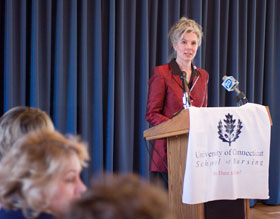  |
| HOME | THIS ISSUE | CALENDAR | GRANTS | BACK ISSUES | < BACK | NEXT > |
Summit: Lack of educators a cause of nursing shortageby Beth Krane - March 13, 2006
|
||||
|
Connecticut will soon be short more than 11,000 nurses, or a third of the nursing workforce needed to care for the state’s patient population. And by 2020, that number is projected to more than double, leaving Connecticut with fewer than half the nurses it needs, according to a report by the U.S. Health Resources and Services Administration. The scope of today’s nursing shortage and the implications of that shortage for nursing education was the topic of a nursing summit organized by faculty from the School of Nursing on Feb. 28 at the law school. The nursing summit, the state’s first, brought together practice-based nurses and nurse educators from hospitals and other healthcare settings across Connecticut and collegiate-based nurse educators. Organizers said the dialogue between practitioners and educators is one step in proactively developing solutions to prevent the impact of the predicted shortage. Representatives from hospitals across the state gave brief presentations on the day-to-day realities of the nursing shortage, as well as thoughts on how student nurses could be even better prepared for the complex and changing profession. “This had never been done. It was historical and it exceeded my expectations,” said Barbara Jacobs, associate professor of nursing, one of the summit’s two organizers. “For the first time, nurses across the state came together with a unified voice and said, ‘We can have a say in how nurses are educated in the state and how they are employed and what this increasingly complex profession will look like in the future’.” The event was covered by state television crews and radio station WTIC-1080. Some were surprised to learn that lack of interest in the nursing profession is no longer a leading cause of the shortage. A variety of factors – from TV commercials about the nursing profession that first aired during the Olympics four years ago, to increasingly competitive starting salaries and an array of incentive and bonus programs – have caused the number of people interested in pursuing nursing careers to surge, said Laura Dzurec, dean of nursing. The School of Nursing typically receives about 750 applications a year, but has capacity for only 200, she said.
The real cause for concern, summit organizers explained, is that there are not enough nursing faculty members to educate all the potential students because many educators are nearing retirement and are not being readily replaced. As well as limited space in the state’s 17 nursing programs, space is tight in clinical settings, where students do necessary rotations and internships. Another factor exacerbating the shortage is an increasingly older and sicker patient population. Many patients have multiple chronic illnesses and need intensive nursing care. Lynn Allchin, an assistant professor of nursing and one of the organizers of the summit, has been a nurse for 30 years. She says the job has changed dramatically since she took care of her first patient. “Thirty years ago I could have taken care of 10 patients, now five is stressing my capacity to safely care for individuals,” she told WTNH Channel 8. One of her recent patients had “two chest tubes, a urinary catheter, oxygen, two IVs, a gastrostomy feeding tube – things that we never would have seen before on a general nursing unit,” she said. Summit participants echoed the organizers’ concerns and made suggestions for improvements. “I foresee nurse-to-patient ratios getting worse, and I foresee nurse dissatisfaction increasing,” said Carol Ghergurovich, the nurse manager of Hartford Hospital’s transplant unit. Ghergurovich suggested resurrecting and updating team nursing models as one possible way to deliver the same quality of care with fewer staff. Elizabeth Winkler, nurse manager of perinatal services from St. Francis Hospital and Medical Center , suggested divesting nurses of non-nursing tasks they are often asked to perform, such as transporting patients. “We need to free up nurses’ time and keep them at patients’ bedsides as much as possible,” she said. “That is how they foster vital relationships with patients that allow them to provide the best care possible. That is the essence of nursing.” |
| ADVANCE HOME UCONN HOME |

